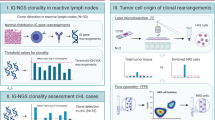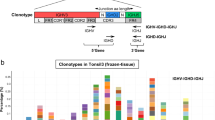Abstract
Mantle cell lymphoma represent a clinicopathologically distinct entity of malignant non-Hodgkin’s lymphoma (NHL) and are characterized by a specific chromosomal translocation t(11;14)(q13;q32) involving the cyclin D1 gene also designated as bcl-1/PRAD1 gene on chromosome 11 and the heavy chain immunoglobulin joining region on chromosome 14. We have established a PCR method to amplify t(11;14) junctional sequences in DNA from fresh frozen and paraffin-embedded tissue by bcl-1-specific primers in combination with a consensus immunoglobulin JH primer. A total of 65 cases histologically classified as mantle cell lymphoma (MCL) were analyzed for the presence of a t(11;14) translocation and monoclonal IgH-CDR3 rearrangements. From 26 patients with classical MCL and three cases with the anaplastic variant of MCL fresh frozen biopsy material was available for DNA extraction. We detected a bcl-1/JH rearrangement in 12 out of 29 samples (41%). In 36 cases paraffin-embedded lymph node tissue was the only source of DNA. In this material we found a bcl-1/JH rearrangement in six out of 31 samples with intact DNA (20%). To confirm the specificity of the PCR and to determine the bcl-1/JH junctional region sequences as clone-specific marker in individual patients we characterized the junctional DNA sequences by direct PCR sequencing in 16 cases. Interestingly we found that six bcl-1/JH junctions harbored DH segments in their N regions indicating that bcl-1/JH rearrangements can occur in a later stage of B cell ontogeny during which the complete VH to DH-JH joining or VH-replacement takes place. To investigate the suitability of IgH-CDR3 as sensitive molecular marker for those MCL patients in which a t(11;14) translocation can not easily be amplified, we additionally analysed 60 cases for the presence of monoclonally rearranged IgH genes by IgH-CDR3-PCR. A monoclonal IgH-CDR3 PCR product could be identified in 24 out of 29 fresh frozen samples (79%) whereas only 11 out of 31 samples (36%) with paraffin-derived DNA were positive. We demonstrate that automated fluorescence detection of monoclonal IgH-CDR3 PCR products allows the rapid and sensitive monitoring of minimal residual disease also in cases that lack a PCR amplifiable t(11;14) translocation. In combination with allele-specific primers the procedure may improve current experimental approaches for detection of occult MCL cells at initial staging and residual disease during and after therapy.
This is a preview of subscription content, access via your institution
Access options
Subscribe to this journal
Receive 12 print issues and online access
$259.00 per year
only $21.58 per issue
Buy this article
- Purchase on Springer Link
- Instant access to full article PDF
Prices may be subject to local taxes which are calculated during checkout
Similar content being viewed by others
Author information
Authors and Affiliations
Rights and permissions
About this article
Cite this article
Pott, C., Tiemann, M., Linke, B. et al. Structure of Bcl-1 and IgH-CDR3 rearrangements as clonal markers in mantle cell lymphomas. Leukemia 12, 1630–1637 (1998). https://doi.org/10.1038/sj.leu.2401172
Received:
Accepted:
Published:
Issue Date:
DOI: https://doi.org/10.1038/sj.leu.2401172
Keywords
This article is cited by
-
Utility of Measurable Residual Disease (MRD) Assessment in Mantle Cell Lymphoma
Current Treatment Options in Oncology (2023)
-
Clinical utility of recently identified diagnostic, prognostic, and predictive molecular biomarkers in mature B-cell neoplasms
Modern Pathology (2017)
-
Next-generation sequencing and real-time quantitative PCR for minimal residual disease detection in B-cell disorders
Leukemia (2014)
-
Long-term clinical and molecular remissions in patients with mantle cell lymphoma following high-dose therapy and autologous stem cell transplantation
Annals of Hematology (2014)



